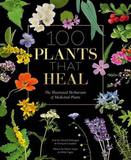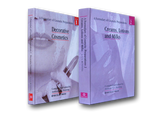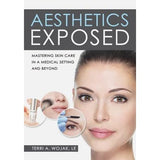Cosmetology – Theory and Practice Research – Test Methods – Analysis – Formulas
Cosmetology – Theory and Practice
Research – Test Methods – Analysis – Formulas
This book represents a symbiosis of two standard works and provides a comprehensive overview of the field of cosmetology. \"Grundlagen und Rezepturen der Kosmetika\" (Schrader) and \"Die kosmetischen Präparate\" (Domsch) have been combined into a text book and reference work in one.
The aim of creating this book was to provide cosmetic chemists, dermatologists, pharmacists and biologists, as well as other scientists involved in cosmetology an introductory overview of the interesting and multifaceted field of cosmetics.
The defining theme of the book "Cosmetology – Theory and Practice – Research -Test Methods – Analysis - Formulas" is to follow the path of cosmetic preparations from research, through the development stage and into the final testing phase.
The editors\' own experiences are paired with contributions from many prominent scientists and colleagues from the same field.
Details zu:
Cosmetology – Theory and Practice (Ladenpreis DE: 190.00EUR)
VOLUME I
1 Hair and Skin – Research Update
1.1 Structure and Chemistry of Human Hair
1.1.1 Introduction
1.1.2 Formation of Hair in the Follicle
1.1.3 Chemical Composition of Hair
1.1.4 Structure and Composition of the Morphological Components of Hair
1.2 Biochemistry of Skin
1.2.1 Structure and Function of Skin
1.2.1.1 The Epidermis
1.2.1.2 The Dermis
1.2.1.3 Melanin and Melanization
1.2.1.4 Cell Cycle
1.2.1.5 Barrier Properties of Skin
1.2.1.6 Sebaceous Glands
1.2.1.7 Finger and Toenails
1.2.1.8 Eccrine Sweat Glands
1.2.2 Hair
2 Test Methods – Compatibility, Efficacy, Safety Evaluation
2.1 Toxicological Characterization
2.1.1 Introduction
2.1.1.1 Supplemental and Alternative Methods: the RRR (Refine, Reduce, Replace) Concept
2.1.1.2 Legal Regulations
2.1.1.3 Institutional Assessment of Supplemental and Alternative Methods: The Way to Acceptance
2.1.1.4 Drug Testing
2.1.1.5 Active Substance Screening: Pharmacodynamic Studies
2.1.2 Acute Toxicity
2.1.3 Toxicity with Repeated Doses (Subacute and Chronic Toxicity)
2.1.4 Reproduction Toxicology: Embryonic, Fetal and Perinatal Toxicity
2.1.5 Genotoxicity and Carcinogenicity
2.1.6 Kinetic Studies
2.1.7 Local Irritancy
2.1.8 Contact Sensitization
2.1.9 Phototoxicity
2.1.10 Quality Control of Drugs
2.1.11 Final Remarks
2.2 Dermatology and Irritation – Compatibility Testing in Human Skin
2.2.1 Statutory Framework
2.2.2 Ethics of Human Testing
2.2.3 Fundamental Principles of Test Planning
2.2.4 Endpoints of Compatibility Testing in Human Skin
2.2.5 Sensitization
2.2.6 Phototoxicity and Photosensitization
2.2.7 Comedogenicity
2.2.8 Subjective Reactions
2.2.9 Instrumental Measurement of Skin Reactions
2.2.10 Value of Predictive Tests
2.3 Biophysical Test Methods – Experimental Proof of Efficacy
2.3.1 Introduction
2.3.2 Moisture Content of the Horny Layer
2.3.3 Skin Surface Profile
2.3.3.1 Quantitative Image Analysis
2.3.3.2 Profilometer – Hommel Tester
2.3.3.3 Laser Profilometry
2.3.3.4 Skinvisiometer SV 500
2.3.3.5 Primos (Phase Shifting Rapid In Vivo Measurement of Skin)
2.3.3.6 FOITS (Fast Optical In Vivo Topometry of Human Skin)
2.3.3.7 Visioscan VC 98 (SELS)
2.3.3.8 Microscopy
2.3.4 Sun Protection
2.3.4.1 UVB Measurement
2.3.4.2 UVA Measurement
2.3.5 Reflectance Spectroscopy
2.3.6 New Perspectives in Efficacy Testing
2.3.6.1 Chemiluminescence
2.3.6.2 ESR – Spectroscopy for Detection of Different Radical Species
2.3.7 Determination of the Skin Surface Lipids
2.3.8 Skin Cleansing
2.3.9 Laser Doppler Flowmetry
2.3.10 Testing of Deodorants and Antiperspirants on Human Skin
2.3.11 Elasticity Measurements
2.4 Application-Oriented Hair Tests
2.4.1 Tensile Properties
2.4.2 Measurement of Hair Thickness
2.4.3 Hair Density Measurement – Trichoscan
2.4.4 Combability In Vitro
2.4.5 Curl Retention (Hairstyle Hold)
2.4.6 Measurement of the Setting Properties
2.4.7 Stickiness (for Polymer-Containing Cosmetics and Raw Materials)
2.4.8 Electrostatic Charging (Flyaway)
2.4.9 Split Hair
2.4.10 Color Measurements on Hair
2.4.11 Physical and Chemical Hair Damage
2.4.12 Half-Head Test
2.4.13 Evaluation of the Lightfastness of Colors in the Packaging
2.4.14 Test for Adequate Preservation
2.4.15 Testing of the Cloud Point
2.4.16 Testing of the Antidandruff Effect
2.4.17 Testing of the Dermatological and Toxicological Properties
2.5 Positioning and Application of Active Ingredients in Cosmetics
3 Outlook
4 Analytical Test Methods
VOLUME II
5 Hair Cosmetics
5.1 Special Features of the Scalp
5.1.1 Dandruff
5.1.2 Greasy Scalp
5.1.3 Dry Scalp
5.1.4 Hair Loss
5.1.5 Scalp Problems (Summary)
5.2 Shampoos
5.2.1 Surfactants
5.2.2 Thickeners (Consistency Modifiers)
5.2.3 Refatting Agents – Hydrophilic Emollients
5.2.4 Pearlescent Agents and Opacifiers
5.2.5 Chelating Agents
5.2.6 Shampoo Formulas
5.2.6.1 Standard Shampoos
5.2.6.2 Mild Shampoos – Baby Shampoos
5.2.6.3 Conditioning Shampoos, 2 in 1 Shampoos
5.2.6.3.1 Conditioning Agents
5.2.6.3.2 Formulas
5.2.6.4 Anti-Dandruff Shampoos
5.2.6.4.1 Dandruff and Anti-Dandruff Actives
5.2.6.4.2 Formulas
5.3 Hair Rinses, Conditioners, Treatments
5.3.1 Global Hair Types
5.3.2 Conditioning Needs for Different Hair Types
5.3.3 Ingredients and Formulas for Hair Rinses
5.4 Hair Tonics
5.4.1 Ingredients for Hair Tonics
5.4.2 Typical Formulas for Hair Tonics
5.5 Styling Products
5.5.1 Ingredients for Styling Products
5.5.2 Styling Gels
5.5.3 Hairsprays
5.5.4 Styling Mousses
5.5.5 Hair Waxes
5.5.6 Styling Creams
5.5.7 Hair Oils
5.5.8 Hair Setting Products
5.5.9 Hair-Reactive Substances
5.6 Hair Coloring Products
5.6.1 Classification of Coloring Products
5.6.1.1 Temporary Colors
5.6.1.2 Semipermanent Colors
5.6.1.3 Permanent Colors
5.6.2 Hair Color Development
5.6.3 Application Technology
5.6.4 Toning Shampoos
5.6.5 Gel Hair Colors
5.6.6 Miscibility of Some Dye Intermediates
5.6.7 Dye Removers
5.6.8 Eyelash and Eyebrow Dyes
5.6.9 Safety of Hair Colors
5.7 Hair Bleaching Products
5.8 Hair Shaping Products (Permanent Waves, Cold Waves)
5.8.1 The Hair
5.8.2 Types of Linkages in Hair
5.8.3 Theory of the Cold Waving Process
5.8.4 Principle of the Sulfite Wave
5.8.5 Principle of the Thioglycolate Wave
5.8.6 Permanent Reshaping
5.8.6.1 Water Wave
5.8.6.2 Cysteine Permanent Wave
5.8.6.3 Acid Permanent Wave
5.8.6.4 Thioglycolic Acid Based Permanent Waves
5.8.7 General Composition of Permanent Waving Products
5.8.8 Application of a Permanent Wave
5.8.9 Safety of Permanent Waving Products
5.8.10 Possibilities for Improving the Perming Process
5.8.11 Neutralizers, Fixatives
5.8.12 Typical Formulas of Permanent Waves and Neutralizers
5.9 Hair Removers
5.10 Hair Relaxers
6 Skin Cleansing
6.1 Bath Additives
6.1.1 Bubble Baths
6.1.2 Shower Baths
6.1.3 Baby Baths and Baby Shampoos
6.1.4 Oil Baths
6.1.4.1 Refatting Oil and Shower Baths
6.1.4.2 Essential Oil Baths
6.2 Liquid Soaps, Wash Lotions
7 Soaps and Syndets
8 Solvent-Based Formulas
8.1 Solvents
8.2 Mouthwashes
8.3 Face Tonics (Face Lotions)
8.4 Fine Fragrances
8.5 Frictions
8.6 Gels
8.6.1 Production of Gels
8.6.2 Raw Materials
8.6.3 Skin Gels and Non-Fat Masks
8.7 Repellents
8.8 Antiperspirants / Deodorants
8.8.1 Active Ingredients
8.8.2 Application Forms
8.8.3 Antiperspirants
8.9 Shaving Aids
8.9.1 Shaving Soaps
8.9.2 Shaving Lotions
9 Oral Hygiene
9.1 Teeth and Oral Cavity as Targets of Cosmetic Care
9.2 Toothpastes
9.3 Gels
9.4 Test Methods
9.5 Denture Care Products
9.6 Typical Formulas
VOLUME III
10 Skin Care
10.1 The Human Skin
10.2 Requirements on Skincare Products
10.3 Differentiation of Skincare Products
10.4 Emulsifiers
10.4.1 Classification of Emulsifiers
10.4.2 Interfacial Properties of Emulsifiers
10.4.3 O/ W Emulsifiers
10.4.3.1 Anionic Emulsifiers
10.4.3.2 Nonionic Emulsifiers
10.4.3.3 Cationic Emulsifiers
10.4.3.4 Polymeric Emulsifiers
10.4.3.5 Amphoteric Emulsifiers
10.4.3.6 Cream Bases
10.4.4 W/O Emulsifiers
10.4.4.1 Metal Soaps
10.4.4.2 Phospholipids
10.4.4.3 Higher Fatty Alcohols
10.4.4.4 Absorption Bases
10.4.4.5 Silicone Emulsifiers
10.4.4.6 Emulsifier Combinations
10.4.4.7 Water Number for Testing W/O Emulsifiers
10.5 Stabilizers
10.6 Oil Components
10.6.1 Selection Criteria
10.6.2 Triglycerides
10.6.3 Silicones
10.6.4 Hydrocarbons
10.6.5 Consistency Regulators
10.6.6 Natural and Natural-Based Waxes and Fats
10.6.7 Fatty Acid Esters of Monohydric Alcohols
10.7 Selected Active Ingredients in Skin Cosmetics
10.7.1 Antioxidants
10.7.2 Vitamins
10.7.3 Ceramides
10.7.4 Anti-Inflammatories (Anti-Irritants)
10.7.5 Keratin-Hardening Substances
10.7.6 Antimicrobial Active Ingredients
10.7.7 Hyperemic Substances
10.7.8 Liposomes
10.7.9 Glycolipids
10.7.10 Lipoproteins
10.8 Emulsions
10.8.1 Determination of the Emulsion Type
10.8.2 Stability and Stabilization of Emulsions
10.8.3 Consistency of Emulsions
10.8.4 General Structure of an Emulsion
10.8.5 O/W Emulsions
10.8.6 W/O Emulsions
10.8.7 Microemulsions
10.8.8 Multiple Emulsions (Mixed Emulsions)
10.8.9 Polyacrylate Emulsions
10.8.10 Gels
10.9 Natural Cosmetics
10.10 Lipid Products
10.10.1 Massage Oils and Gels
10.10.2 Body Oils and Gels
10.10.3 Baby Oils and Lipogels
10.10.4 Cleansing Oils and Gels
11 Sunscreen Formulas
11.1 Basic Principles
11.2 Sun Protection for Products
11.3 Micropigments
11.4 UV Filters
11.5 Products with Polymeric Emulsifiers
11.6 Typical Formulas for Sunscreen Products
11.7 After Sun Formulas
11.8 Skin Tanning Products
11.9 Whitening – Hyperpigmentations and their Treatment
12 Color Cosmetics
12.1 Cosmetic Colorants and Fillers
12.2 Lip Color
12.2.1 Common Lipstick Formulas
12.2.2 Long-Lasting Lipstick Formulas
12.2.3 Water-Containing Lipstick Formulas
12.2.4 Development Support
12.2.5 Production and Quality Control
12.2.6 Lip Gloss Formulas
12.2.7 Lip Powders
12.3 Eye Shadow, Face and Rouge Powders, Compact Creams and Sticks
12.3.1 Eye Shadow, Face and Rouge Powders
12.3.2 Compact Cream Formulas
12.3.3 Stick Formulas
12.3.4 Water-Containing Compact Cream Foundations
12.4 Mascara
12.5 Eyeliner Formulas
12.6 Face Color
12.7 Removers for Face and Eye Makeup
12.8 Nail Color
12.8.1 Colored Nail Polish
12.8.2 Fast Drying Formulas
12.8.3 Water-Based Formulas
12.8.4 Base and Top Coat
12.8.5 Nail Polish Dryer Formulas
12.8.6 Nail Polish Remover Formulas
12.8.7 Nail Care
12.9 Cosmetic Pencils for Lips, Eyes and Nails
13 Aerosols
13.1 Introduction, Definition
13.2 Principle of the Aerosol System
13.3 Aerosol Containers
13.4 Propellants
13.5 Filling Technology
13.6 Legal Regulation – Safety and Environmental Considerations
13.7 Two-Phase Aerosols
13.8 Three-Phase Aerosols
13.9 Emulsion Aerosols
13.10 Suspension Aerosols
13.11 Bicompartmental Aerosols
13.12 Formulas
13.12.1 Hairsprays
13.12.2 Deodorant Sprays and Antiperspirant Sprays (AP Sprays)
13.12.3 Styling Mousses
13.12.4 Color Mousses
13.12.5 Shaving Foams
13.12.6 Bicompartmental Shaving Gels
13.12.7 Aerosol Shampoos
14 Preservation
14.1 Preservatives
14.1.1 Preservative-Free Cosmetics
14.1.2 Antimicrobial Effect of Surfactant Concentrates
14.2 Preservation Tests
14.2.1 Legal Principles
14.2.2 Test for Adequate Preservation
14.2.3 The Repeated Challenge Test
14.2.4 The In-Use Test
15 Antioxidants for Product Protection
16 Cosmetics Production Technology
16.1 General Technologies
16.1.1 Water Treatment
16.1.2 Microbial Reduction
16.2 Production Hygiene
16.3 Heat Exchange
16.4 Pumps
16.5 Mixing and Stirring
16.6 Production of Aqueous and Alcoholic Solutions
16.7 Production of Surfactant Products
16.8 Preparation of Syndet Bars
16.9 Emulsion Production Technology
16.10 Paste Production Technology
The editors' task was to coordinate all of the contributions and opinions.
The field of cosmetology today is extremely varied and extensive, and as a result, some topics must remain incomplete within the context of this book. Other topics are examined with particular care, for example, fragrance oils and their composition. The scope of this already voluminous work allowed for no further compromises.


















